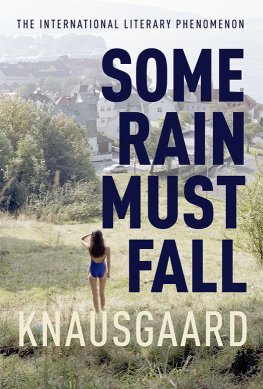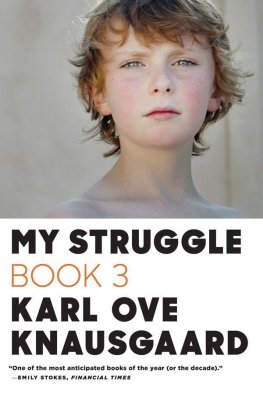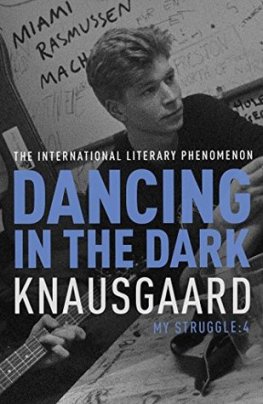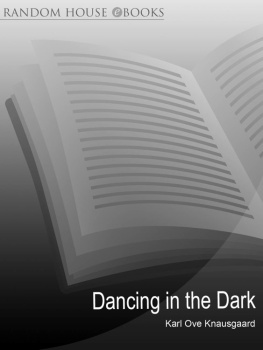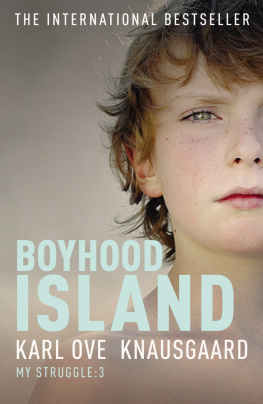
Karl Ove Knausgaard
My Struggle
Translated from the Norwegian by Don Bartlett
archipelago books
Copyright Karl Ove Knausgaard, 2009
English language translation Don Bartlett, 2012
First Archipelago Books Edition, 2012
All rights reserved. No part of this book may be reproduced or transmitted in any form without the prior written permission of the publisher.
First published as Min kamp 1 by Forgalet Oktober in 2009.
Archipelago Books
232 3rd Street, Suite A111
Brooklyn, NY 11215
www.archipelagobooks.org
Library of Congress Cataloging-in-Publication Data
Knausgrd, Karl Ove, 1968
[Min kamp. English]
My struggle / Karl Ove Knausgaard ; translated from the Norwegian
by Don Bartlett. 1st Archipelago Books ed.
p. cm.
ISBN 978-1-935744-52-8
I. Bartlett, Don. II. Title.
PT8951.21.N38M5613 2012
839.82'37dc23 2011048978
Distributed by Consortium Book Sales and Distribution
www.cbsd.com
Cover art: Anselm Kiefer
The publication of My Struggle was made possible with support from Lannan Foundation, the National Endowment for the Arts, the New York State Council on the Arts, a state agency, NORLA (Norwegian Literature Abroad), and the New York City Department of Cultural Affairs.

Contents
F or the heart, life is simple: it beats for as long as it can. Then it stops. Sooner or later, one day, this pounding action will cease of its own accord, and the blood will begin to run towards the bodys lowest point, where it will collect in a small pool, visible from outside as a dark, soft patch on ever whitening skin, as the temperature sinks, the limbs stiffen and the intestines drain. These changes in the first hours occur so slowly and take place with such inexorability that there is something almost ritualistic about them, as though life capitulates according to specific rules, a kind of gentlemans agreement to which the representatives of death also adhere, inasmuch as they always wait until life has retreated before they launch their invasion of the new landscape. By which point, however, the invasion is irrevocable. The enormous hordes of bacteria that begin to infiltrate the bodys innards cannot be halted. Had they but tried a few hours earlier, they would have met with immediate resistance; however everything around them is quiet now, as they delve deeper and deeper into the moist darkness. They advance on the Havers Channels, the Crypts of Lieberkhn, the Isles of Langerhans. They proceed to Bowmans Capsule in the Renes, Clarks Column in the Spinalis, the black substance in the Mesencephalon. And they arrive at the heart. As yet, it is intact, but deprived of the activity to which end its whole construction has been designed, there is something strangely desolate about it, like a production plant that workers have been forced to flee in haste, or so it appears, the stationary vehicles shining yellow against the darkness of the forest, the huts deserted, a line of fully loaded cable- buckets stretching up the hillside.
The moment life departs the body, it belongs to death. At one with lamps, suitcases, carpets, door handles, windows. Fields, marshes, streams, mountains, clouds, the sky. None of these is alien to us. We are constantly surrounded by objects and phenomena from the realm of death. Nonetheless, there are few things that arouse in us greater distaste than to a see a human being caught up in it, at least if we are to judge by the efforts we make to keep corpses out of sight. In larger hospitals they are not only hidden away in discrete, inaccessible rooms, even the pathways there are concealed, with their own elevators and basement corridors, and should you stumble upon one of them, the dead bodies being wheeled by are always covered. When they have to be transported from the hospital it is through a dedicated exit, into vehicles with tinted glass; in the church grounds there is a separate, windowless room for them; during the funeral ceremony they lie in closed coffins until they are lowered into the earth or cremated in the oven. It is hard to imagine what practical purpose this procedure might serve. The uncovered bodies could be wheeled along the hospital corridors, for example, and thence be transported in an ordinary taxi without this posing a particular risk to anyone. The elderly man who dies during a cinema performance might just as well remain in his seat until the film is over, and during the next two for that matter. The teacher who has a heart attack in the school playground does not necessarily have to be driven away immediately; no damage is done by leaving him where he is until the caretaker has time to attend to him, even though that might not be until sometime in the late afternoon or evening. What difference would it make if a bird were to alight on him and take a peck? Would what awaits him in the grave be any better just because it is hidden? As long as the dead are not in the way there is no need for any rush, they cannot die a second time. Cold snaps in the winter should be particularly propitious in such circumstances. The homeless who freeze to death on benches and in doorways, the suicidal who jump off high buildings and bridges, elderly women who fall down staircases, traffic victims trapped in wrecked cars, the young man who, in a drunken stupor, falls into the lake after a night on the town, the small girl who ends up under the wheel of a bus, why all this haste to remove them from the public eye? Decency? What could be more decent than to allow the girls mother and father to see her an hour or two later, lying in the snow at the site of the accident, in full view, her crushed head and the rest of her body, her blood-spattered hair and the spotless padded jacket? Visible to the whole world, no secrets, the way she was. But even this one hour in the snow is unthinkable. A town that does not keep its dead out of sight, that leaves people where they died, on highways and byways, in parks and parking lots, is not a town but a hell. The fact that this hell reflects our life experience in a more realistic and essentially truer way is of no consequence. We know this is how it is, but we do not want to face it. Hence the collective act of repression symbolized by the concealment of our dead.
What exactly it is that is being repressed, however, is not so easy to say. It cannot be death itself, for its presence in society is much too prominent. The number of deaths reported in newspapers or shown on the TV news every day varies slightly according to circumstances, but the annual average will presumably tend to be constant, and since it is spread over so many channels virtually impossible to avoid. Yet that kind of death does not seem threatening. Quite the contrary, it is something we are drawn to and will happily pay to see. Add the enormously high body count in fiction and it becomes even harder to understand the system that keeps death out of sight. If the phenomenon of death does not frighten us, why then this distaste for dead bodies? It must mean either that there are two kinds of death or that there is a disparity between our conception of death and death as it actually turns out to be, which in effect boils down to the same thing. What is significant here is that our conception of death is so strongly rooted in our consciousness that we are not only shaken when we see that reality deviates from it, but we also try to conceal this with all the means at our disposal. Not as a result of some form of conscious deliberation, as has been the case with funeral rites, the form and meaning of which are negotiable nowadays, and thus have shifted from the sphere of the irrational to the rational, from the collective to the individual no, the way we remove bodies has never been the subject of debate, it has always been just something we have done, out of a necessity for which no one can state a reason but everyone feels: if your father dies on the lawn one windswept Sunday in autumn, you carry him indoors if you can, and if you cant, you at least cover him with a blanket. This impulse, however, is not the only one we have with regard to the dead. No less conspicuous than our hiding the corpses is the fact that we always lower them to ground level as fast as possible. A hospital that transports its bodies upward, that sites its cold chambers on the upper floors is practically inconceivable. The dead are stored as close to the ground as possible. And the same principle applies to the agencies that attend them; an insurance company may well have its offices on the eighth floor, but not a funeral parlor. All funeral parlors have their offices as close to street level as possible. Why this should be so is hard to say; one might be tempted to believe that it was based on some ancient convention that originally had a practical purpose, such as a cellar being cold and therefore best suited to storing corpses, and that this principle had been retained in our era of refrigerators and cold-storage rooms, had it not been for the notion that transporting bodies upward in buildings seems
Next page


